Selective Mutism IEP/504 Goals, Choice of Therapy, Activities & How to Normalize Anxiety for an Anxious Child.
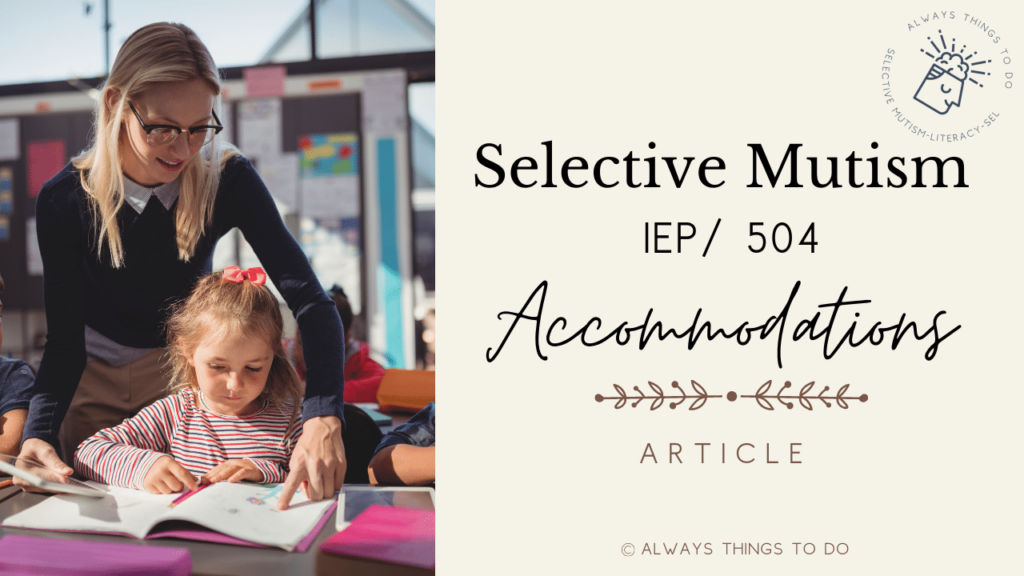
In this post, learn about:
- how to choose best selective mutism IEP goals,
- how to make selective mutism IEP accommodations actionable (turning them into goals),
- why the choice of therapy for selective mutism was never our priority,
- what made the difference for my child with selective mutism,
- how not to lose hope.
Selective Mutism IEP Goals are Very Unique for Each Child and Each Family Circumstances.
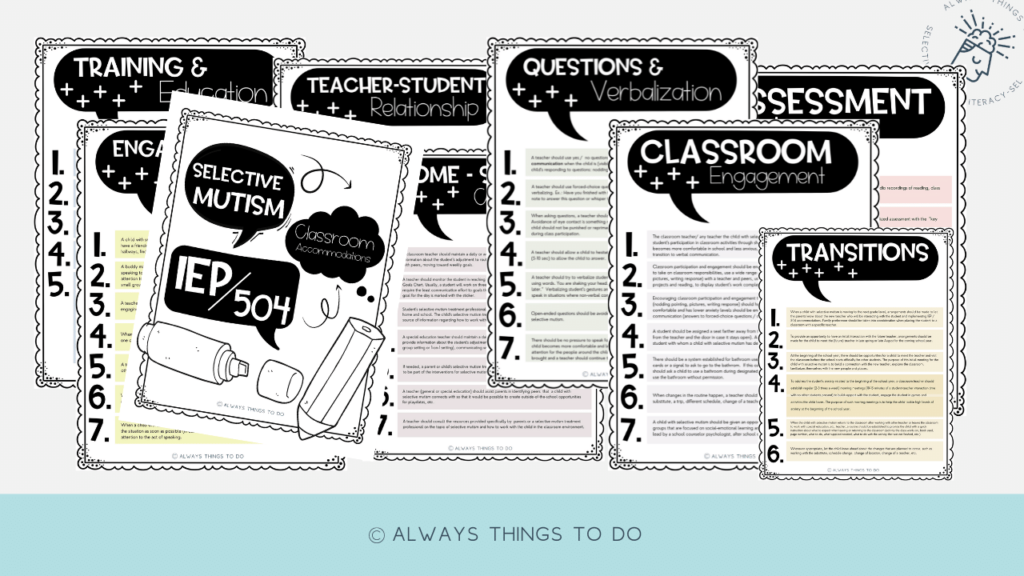
Before I share with you everything I learned about selective mutism IEP (504) goals and how to craft them, let me burst your bubble:
You are probably tired and overwhelmed dealing with selective mutism and school issues. I dare to ask is it because you expect too much from the educational system that is not built to handle unique and rare conditions such as selective mutism? Or are you expecting too much from an anxious child and are not willing to accept the longer and slower pace of recovery from selective mutism?
You would probably get defensive and ask me “What’s “normal” and acceptable about a child who can’t eat lunch or drink the whole day, have bathroom accidents, or is even petrified of bathrooms, have a continuous meltdown, and is oppositional when it comes to school or any social contact?
You are right.
There is nothing “normal” or acceptable about selective mutism. But what I have come to realize about my family’s 3-year “battle” with selective mutism is that the more I fought and the more persistent I was in “fixing” my child, the more overwhelm I experienced and the unhappier my child would become.
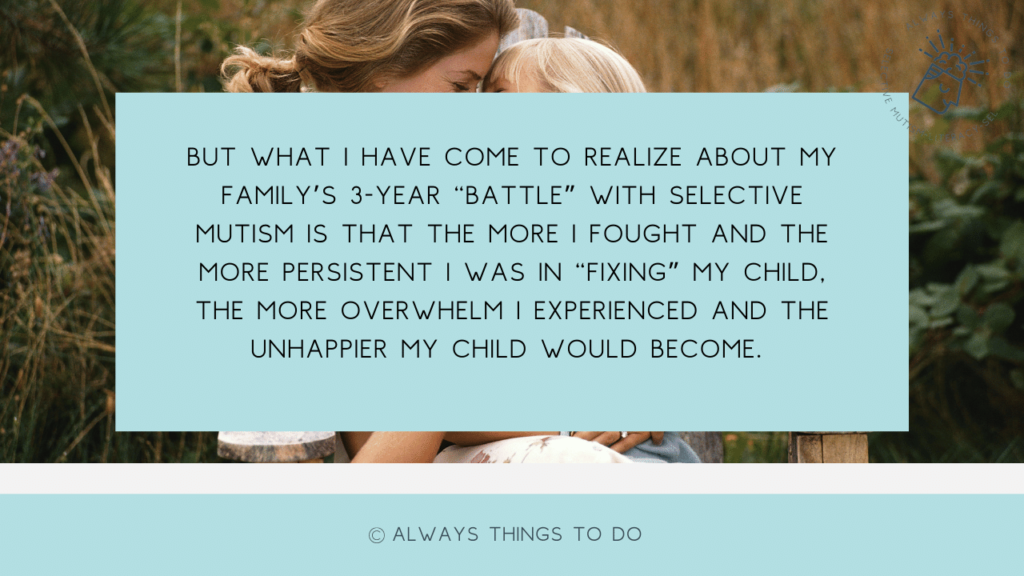
I hear you when you explain all the difficulties your little one experiences, all the hardships you need to go through to, maybe, convince the school that selective mutism is real, all the things you have tried before your child refused to go to school again because of the panic attacks.
My daughter’s selective mutism is, probably, not the worst one out of all the possible ways selective mutism can manifest in a child. We surely did have our struggles and fears: bathroom issues and accidents, extreme moodiness and unhappiness, academic problems, reluctance with homework, “I’m-a-bad-kid” moments, “no-one-loves-me” moments, “I’m-so-lonely” moments.
I’m now sure it could have been worse, but we are finally getting our heads above water.
Selective mutism is a family thing. If you are a parent of a selective mutism child, you know what I mean. It’s not just about speaking. It’s by far not about speaking at all. It’s how selective mutism in your child changes the family, challenges the family, and gets the family back together despite of many tries of being “normal.”
And I’m here to say that’s OK to NOT be “normal” for a while.
Just accept it.
Don’t fight it.
Take my words as the beacon of hope that selective mutism will NOT be there forever.
Well, back to reality now. If you are still reading, then you really need to figure things out with selective mutism IEP / 504 goals. Let’s dive in then.
First of all, it’s better to get things right. We are talking about selective mutism IEP / 504 ACCOMMODATIONS, not GOALS. I will explain the difference in a moment.
If your child already has an IEP or 504 plan, you might have already had an IEP meeting where accommodations have been discussed.
If your child does not have an IEP, I suggest reading “Selective Mutism Classroom Accommodations: What You Need To Know About 504 and IEP.” If you are still not convinced how your child may benefit from an IEP, read this article about how selective mutism disability impacts the child.
So, what’s a selective mutism IEP accommodations?
Accommodations listed in your child’s IEP or 504 plan describe how the school environment and communication will be changed to ACCOMMODATE a child with selective mutism.
Selective mutism IEP accommodations give clues to educators working with your child about how they can change the classroom environment and their communication patterns to make sure they are responsive to your child’s needs.
Selective mutism IEP accommodations are NOT goals. A goal is something that is set to be achieved.
For example, “Jack is going to use a chosen hand signal to communicate to the teacher his bathroom needs twice a day for a period of two consecutive weeks.” That’s a goal. Let’s talk about SMART goals a bit later.
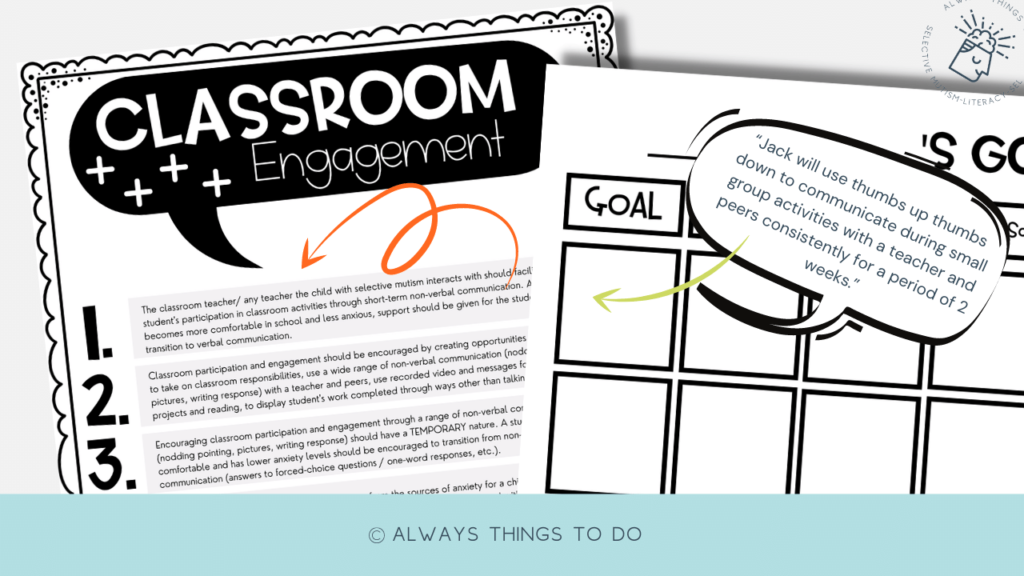
Now, accommodation in your child’s IEP may say “A teacher will use a system of communication with a child to address the bathroom needs.” That’s accommodation. The teacher will be required to accommodate the child through using a certain system of communication discussed with the parents (for example, hand signals, pictures, etc.).
All in all, accommodations are quite GENERAL. Goals are more specific and measurable.
What are the best selective mutism IEP/ 504 accommodations?
Great question!
The answer is – it depends on your child.
Every child with selective mutism functions on their unique anxiety level. The difficulties one child with selective mutism may experience may not be the same across the board for all children with selective mutism.
Therefore, the choice of accommodations for your child’s EIP and 504 will depend on what your child’s current struggles are what level of anxiety your child experiences in a school setting.
One more important point is that I urge you to be an active decision-maker in selecting and agreeing on accommodations for your child’s IEP or 504 plan.
Why?
Educational professionals in your school district probably have no or little knowledge or experience with selective mutism. A parent and the child’s selective mutism treatment professional are the decision-makers in crafting selective mutism accommodations for a child.
Need advice on formulating selective mutism IEP / 504 accommodations?
Sure!
Check the “Selective Mutism Home-School Parent Toolkit” which has IEP/ 504 accommodations along with other awesome resources for parents. The examples of IEP/ 504 accommodations cover the areas of:
- Classroom engagement
- Teacher-student relationship
- Questions and verbalization
- Assessment
- Engagement with peers
- Home-school connection
- Transitions
- Training and education
The preview of accommodations is below.
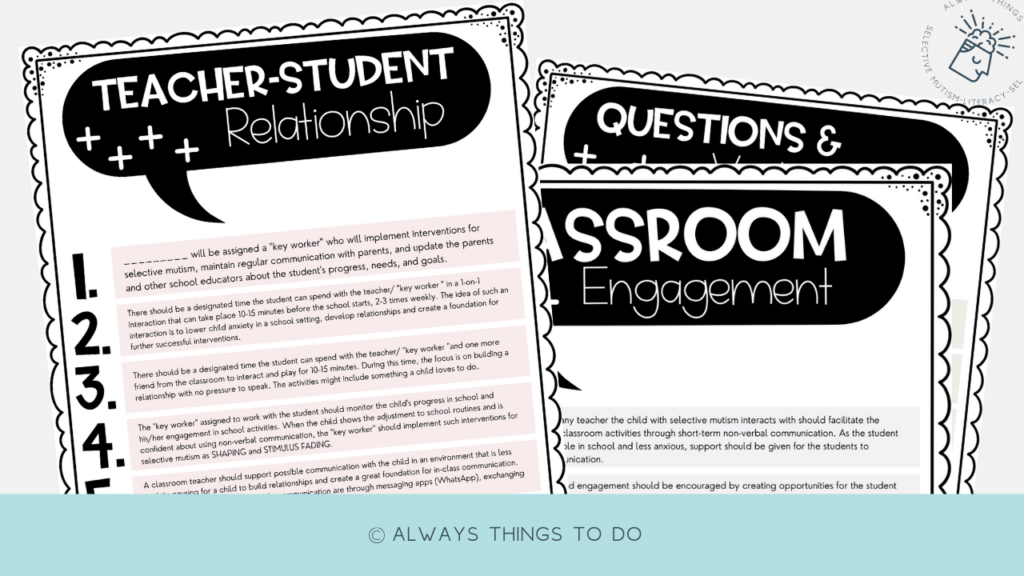
Selective mutism goals. What are those and how are they different from accommodations?
As I said earlier, selective mutism accommodations in your child’s IEP are very general and contain clues for educators on how to accommodate your child in a classroom environment and by modifying their communication patterns.
The goal that your child can work on weekly can be related to the accommodations but are more specific and measurable.
For example, a child has trouble participating in classroom activities due to obvious reasons. The accommodation in your child’s IEP may say:
“The classroom teacher/ any teacher the child with selective mutism interacts with should facilitate the student’s participation in classroom activities through short-term non-verbal communication. As the student becomes more comfortable in school and less anxious, support should be given for the students to transition to verbal communication.” <– see below
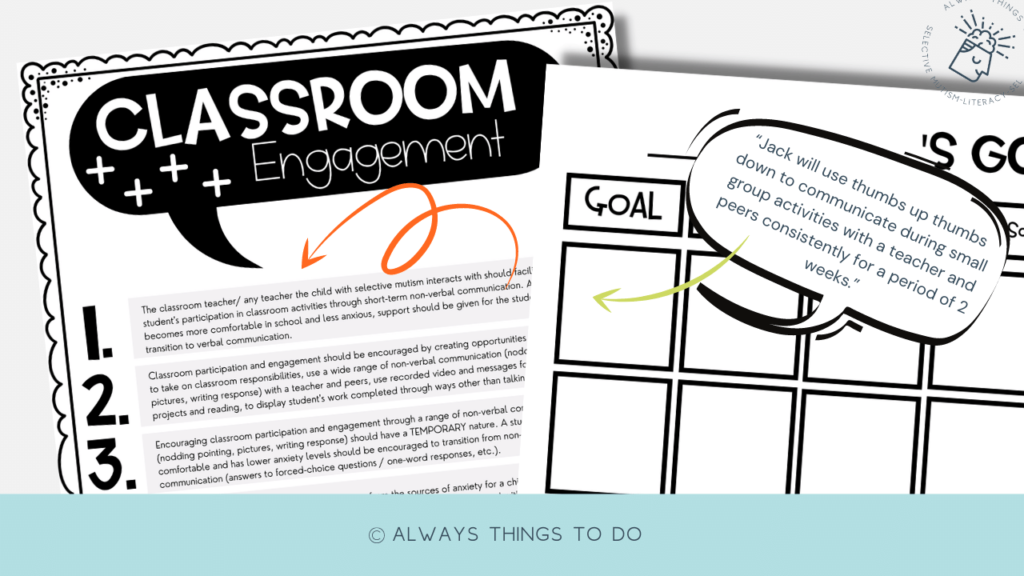
The goal for your child might be formulated as follows:
“Jack will use thumbs up thumbs down to communicate during small group activities with a teacher and peers consistently for a period of 2 weeks.” see the goal above
That’s a smart goal that can be incorporated into a reward chart that tracks your child’s behavior and progression towards certain goals in a classroom. This goal is also a SMART goal.
- S – specific: a child’s goals is to use hand signals to participate.
- M – measurable: a child receives a sticker as a reward if he/she demonstrates the desired behavior.
- A – achievable: using gestures is easier for a child with anxiety that verbal communication at the beginning of the school year.
- R- relevant: if the child is yet non-verbal, using hand signals is relevant.
- T – timebound: the child is expected to show this consistent behavior for 2 weeks.
The reward chart is actually an awesome idea to implement in your child’s school routines. Everything you need is to let the teacher know that a child will be working on 3 specific goals. Explain briefly how tracking of behavior works (with stickers). Formulate the goals that are appropriate for your child.
Create a chart on paper or use my resource done and crafted for you.
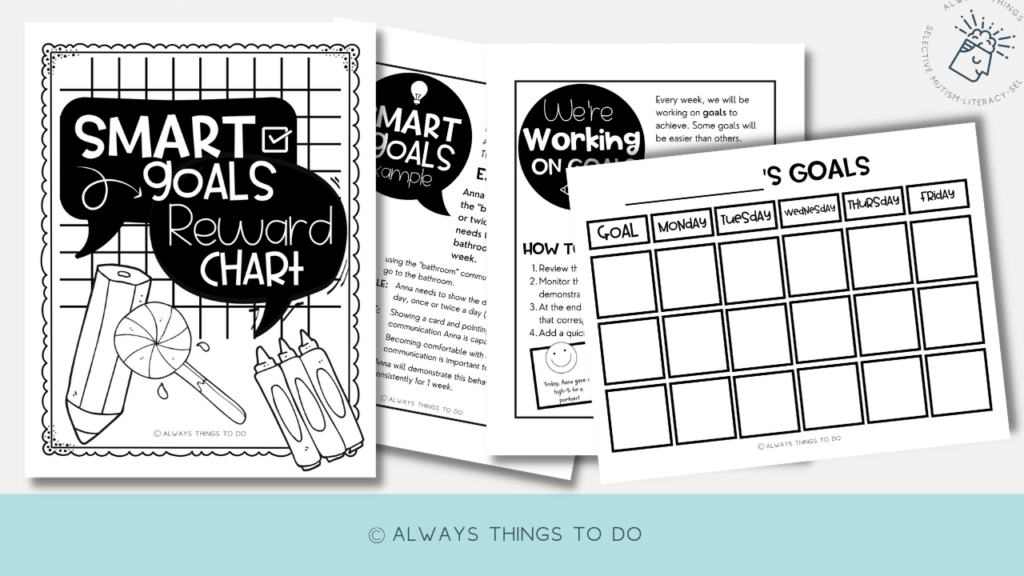
“Smart Goals Reward Chart” is a resource that:
- Will explain the teacher what the idea is behind,
- Will give you an example of what a SMART goal is,
- Will provide a chart for you to print and use.
Explore the “Smart Goals Reward Chart” as part of the “Selective Mutism Home-School Parent Toolkit.”
Check out these free versions of reward charts: reward chart for school and home.
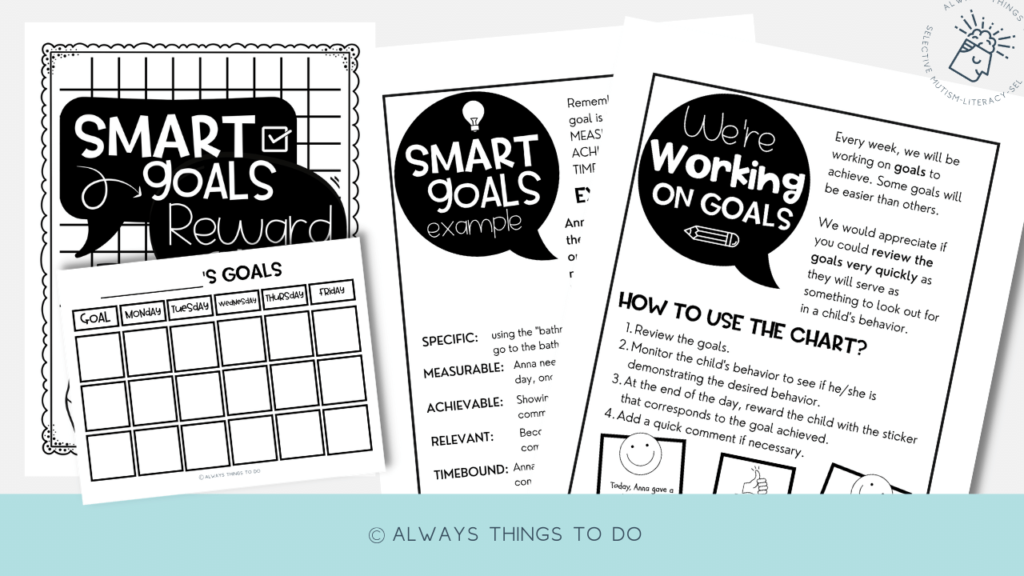
Selective Mutism Therapy: What Works for Your Child?
In three years of dealing with selective mutism, I’ve heard many names of therapies. Some of them sounded familiar, most didn’t.
Looking back to our 3-year journey, I can say for sure that in my child’s selective mutism recovery we never focused on one particular therapy.
In fact, therapy is not something I ever mentioned to our selective mutism treatment professional nor did she ever present what she did in selective mutism treatment sessions as therapy.
It almost seems like trying to find a golden bullet for a problem that impacts so many areas: mental, physical, academics, family relationships.
The problem with any therapy is that it will be too limiting, it may not work for your child, it may be too expensive.
Even now, after three years and some great results in treating selective mutism for my child, I cannot tell for sure whether we used a particular therapy even though we changed and tried many things.
What I knew for sure three years ago when my child was diagnosed is that it was not possible to afford New York camps (we live in New Jersey), nor did I see a need to push my child into speaking within 1 week…
Almost intuitively I also knew that speaking was a secondary issue. The big elephant in the room was the anxiety itself and how it manifested every day in my child’s mood swings, screaming, low self-esteem, anger, and tantrum.
Selective mutism therapy for us over three years included:
- biweekly sessions with our selective mutism therapist (so many games played and such great friendship developed)
- addressing tantrums at home
- acknowledging the issue of anxiety I experienced as a mom
- dealing with family downs and relationship crisis that selective mutism brought in
- incorporating social-emotional education in my child’s upbringing
- deciding on a difficult issue of medication
- addressing academic issues with robust home support and communication with teachers
- reevaluating my priorities as a mom
- “normalizing” who my child was and is
- accepting selective mutism as a long but a passing stage
In addition, within the three years of treating selective mutism, three things seemed to bear fruit and impact my child’s in an amazing way:
- Consistency in therapy sessions with the same selective mutism treatment professional
- Addressing social-emotional issues
- Robust and continuous communication with school to make sure my child is supported
While communication with the school is a topic in itself and the choice of selective mutism treatment professional is individual, the social-emotional aspect is any child’s upbringing is so relevant.
As a parent of a child with selective mutism, you face selective mutism and its manifestation in a child every single day. You notice patterns and behaviors.
Addressing what happens at home with a particular therapy is almost impossible because all therapies target the speaking aspect of selective mutism. Yet, I would like to share some advice that might be useful since you may be going through similar troubles.
“Selective Mutism Home-School Parent Toolkit” has two amazing resources that I create based on observations of my child.
The first resource is the “Selective Mutism Toolkit.” It talks about the 15 most common issues children with selective mutism experience and how to address them.
- Noise
- Fear of homework
- Making mistakes
- Your child mirrors your anxiety
- Hard to make choices
- Routines
- Negative self-perception
- Space for anger
- Understanding jokes, etc.
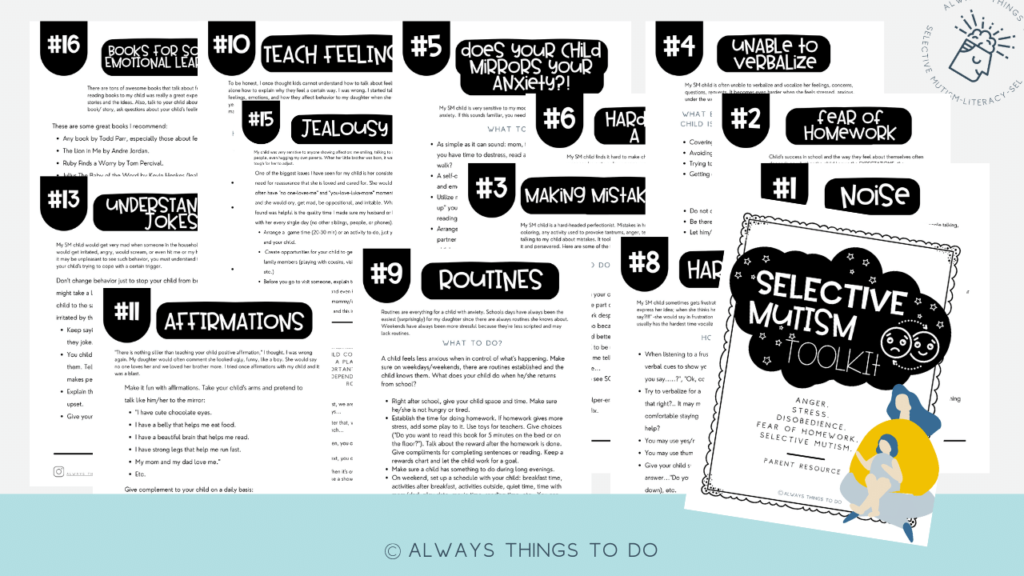
The second resource is “How To Help an Angry Child.” It will give you tips and advice on the following issues:
- What anxiety feels and looks like and what to do
- Teach this language to acknowledge emotions
- Help your kiddo cope with big feelings
- Homework issues and how to help
- Building confidence and rewarding
- Anger and disobedience
- How to give back control and foster independence, etc.
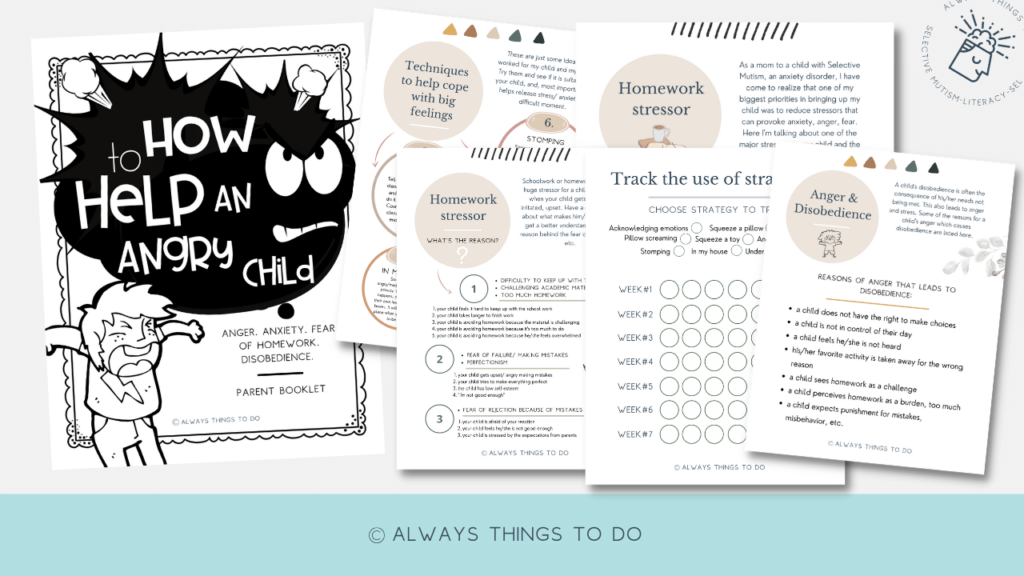
Selective Mutism Activities & What To Do To Normalize Anxiety for an Anxious Child.
I still remember those hard days when selective mutism could show its ugly side. After the period of screaming and me going out of my mind to handle the situation, I would always leave the house to somehow calm myself and stay sane.
If your child shows moodiness, meltdown, and anger, it’s quite hard to even realize that the opposite is normal and possible.
It was about two years ago that I could not see anything but a defiant, bossy, moody child of mine. I blamed myself for being a horrible mother. I hated everything, my own anxiety would show up on a regular basis, and I would hear more and more often from my daughter, “Are you angry at me?”
You see, I didn’t know many things I know now about selective mutism let alone interpret in a correct way my child’s behavior and mood. It was difficult to hope for “normalcy” when everything seems to be so chaotic.
Fast-forward now, I can surely say I had to “normalize”, to OK anxiety for my child and myself, too. What became “normal” did not seem so scary after some time of getting used to it:
- Showing big feelings is OK.
- Having a bathroom issues is OK (things happen).
- Not speaking (it happens) is OK.
- Having troubles at school with Math or ELA is OK.
- Having behavior hick-up is OK.
- Having selective mutism is OK.
- Taking medication is OK.
- Confusing numbers in second grade is OK.
Among the activities that were helpful to my child on our journey of handling selective mutism:
- Playdates with the selected friend (non-verbal communication)
- Reading books and books about feelings, anxiety and being different
- Trying new things with NO expectation for a child to participate or to speak
- Creating a much stronger mom-daughter connection through quality time and acceptance of whatever happens
Explore this selection of books about anxiety, feelings, worry, being different. It’s also part of the “Selective Mutism Home-School Parent Toolkit.” My advice, gift some books to your child’s teacher to read during read-alouds.

Check out these creative and find ways to ask your child about school without annoying them. The resource is part of the “Selective Mutism Home-School Parent Toolkit”.

One last word of advice from a mom of a child with selective mutism:
“Remember, selective mutism will not be there forever. Accept what the life is with selective mutism now. Normalize it. And do not focus on speaking at the very beginning. Focus on your child’s anxiety and feelings. Changes will come. I promise.“
If you liked the information in this post, make sure you explore other posts about selective mutism:
- “What Is Selective Mutism?”
- “Selective Mutism: How To Beat Crisis, Screaming, and Fear.”
- Diagnosis of Selective Mutism: Simple Parent Guide and Steps to Take.
- What Are The Causes of Selective Mutism?
- Is Selective Mutism a Disability?
- How Do You Treat Selective Mutism?
- 70 Selective Mutsim Symptoms & 3 Diagnostic Criteria.
- Selective Mutism Myths: Most Common Concerns Addressed.
- Selective Mutism Classroom Accommodations: What You Need To Know About 504 and IEP.
Check out the expanding library of tools. Go to the selective mutism page and scroll to the bottom section, “Latest Projects.”
Connect with me on social media @alwaysthingstodo.
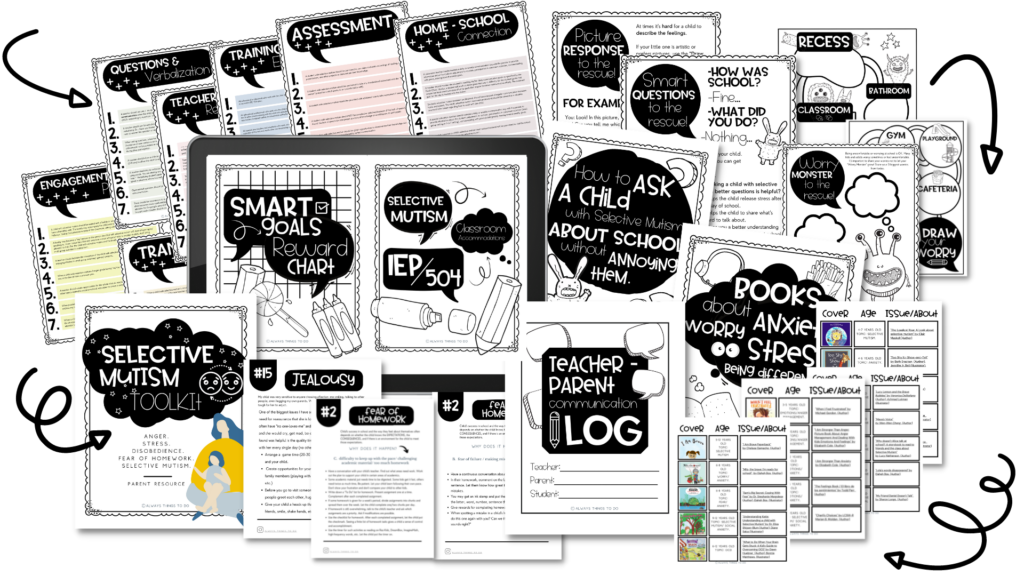




One Comment
Pingback: